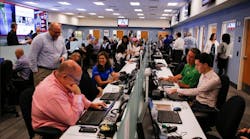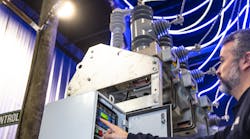Florida Power & Light Co. (FPL) recently tested the response of more than 3000 employees to a hypothetical hurricane with characteristics similar to that of a more than 100-year old hurricane that made landfall in two parts of the state. During the annual hurricane drill, the FPL staff coordinated its efforts at its command center in Riviera Beach, Florida. Located next to the command center is the new distribution control center, a state-of-the-art, Category 5-rated building that enhances the company’s abilities to respond to natural disasters, and efficiently monitors thousands of smart devices and other equipment 24X7 to reduce outages when they occur.
The weeklong drill is a critical component of the FPL's extensive year-round training to ensure employees are ready to respond when their customers need them the most.
As part of the exercise, the hypothetical Hurricane Haley, which mimicked 1903’s Hurricane 3, first made landfall in Miami-Dade County on May 2 as a Category 1 hurricane. The storm then exited the west coast, steered north through the Gulf of Mexico and made a second landfall in the Pensacola area. During the simulated exercise, the FPL employees were evaluated on their response and restoration efforts with regard to operations, logistics, communications and customer service, among other areas.
The drill, which included local first responders, provided an opportunity to demonstrate how the FPL is continuously improving its efforts, and is “ready to respond together” with its partners and return life to normal for millions of Floridians in their greatest time of need.
“In Florida, it is not a matter of if, but when a hurricane will impact a portion of our state, as we saw with last year’s devastating Hurricane Michael,” said Eric Silagy, FPL president and CEO. “While we may not know exactly when and where a hurricane will strike, we know that we must always be prepared to restore power to Floridians or others who need us. Every year, our drill is a commitment to push ourselves and improve upon our procedures when responding to a natural disaster.”
In addition to the distribution control center, the company completed the following last year:
- Built 12 hardened service centers throughout the state, which will help the company pre-stage equipment, and more than 1000 personnel to restore power safely and quickly once a hurricane passes
- Improved and tested its communication systems to ensure the company can provide efficient and accurate information about when power will be restored to customers by capitalizing on smart grid technology
- Provided customers an opportunity to directly report to the company when they see a downed power line, which will accelerate efforts to restore power
“While much of the FPL’s service area was spared the catastrophic effects of last year’s Hurricane Michael, we are always making improvements to our system to make it ready for day-to-day operations and for whatever mother nature throws our way,” said Manny Miranda, senior vice president of power delivery for the FPL. “In addition, our crews were part of an active 2018 hurricane season that took them throughout the Southeast and elsewhere to help our fellow citizens in need.”
Last year, FPL crews assisted in restoring power to:
- Residents of Puerto Rico, still reeling from the effects of 2017’s Hurricane Maria
- The Carolinas after Hurricane Florence
- Parts of Florida’s Panhandle and southern Georgia after Hurricane Michael
- Northern California in the aftermath of the Camp Fire
The FPL is often called upon to assist other energy companies after a natural disaster because of the preparation the company crews go through prior to the storm season and their response to past storms, including Hurricane Irma. The company participates in mutual assistance programs with other energy companies from across the nation. Companies from outside Florida have sent crews to help Floridians after major storms. In 2017, the FPL’s storm restoration workforce of 28,000, which included nearly 20,000 workers from 30 states and Canada, played a critical role in the record setting restoration of more than 4.4 million customers following Hurricane Irma.
Investments to Help Restore Customers’ Service Faster, More Efficiently
Since 2006, the FPL has invested nearly US$4 billion to strengthen its energy grid, which has improved reliability in day-to-day operations and during the hurricane season. These investments minimized damage and sped restoration efforts during 2016’s Hurricane Matthew and 2017’s Hurricane Irma, while also improving overall service to customers. These investments include:
- Hardening or undergrounding 98% of main power lines serving critical community functions and services, such as police and fire stations, hospitals, ports, and 911 centers
- Clearing trees and vegetation — a major cause of power outages — from more than 15,000 miles of power lines each year, which is equivalent to a round trip flight from Miami to Tokyo
- Inspecting all of the company’s 1.2 million distribution power poles within an eight-year cycle, and upgrading or replacing those that no longer meet the FPL's industry leading standards for strength (approximately 150,000 poles inspected annually)
- Installing more than five million smart meters and more than 110,000 intelligent devices to help predict, reduce, and prevent power outages, and restore power faster if outages occur
- Replacing transmission structures (currently 93% are concrete or steel)
The company also announced its plans in March to continue hardening the energy grid over the next three years by additionally investing approximately US$2 billion, which includes hardening its main power lines and replacing all remaining wooden transmission structures. By the end of 2022, the FPL expects that all of its transmission structures will be steel or concrete. By the end of 2024, the company expects to have hardened or placed underground all main power lines within its distribution system, including those serving critical and key community facilities.
Hardening means that the FPL is upgrading the energy grid to meet national standards for extreme wind conditions throughout the company’s service area, which includes installing power poles that can be a combination of wood and concrete. Hardening also includes shortening the span between poles by installing additional poles and possibly placing some sections of power lines underground.
In addition to being more storm resilient, hardened power lines perform 40% better in day-to-day operations than those power lines that are not hardened, which means fewer outages experienced by customers.
How to Connect with the FPL During a Storm
While investments in building a stronger and smarter energy grid demonstrated benefits to customers during Hurricane Irma and past hurricanes, the FPL reminds its customers that every storm is different, along with the damage that comes with it, and urges them to prepare for the upcoming hurricane season.
Throughout the year, the company provides information to customers to help them prepare for the hurricane season and communicates with them after a severe weather event. FPL.com/storm features checklists and other information to help customers prepare and develop their own hurricane plans. When a real hurricane strikes, the FPL will provide updated restoration time estimates and other progress reports in the locations listed below:
- FPL Storm Center (www.FPL.com/storm)
- Twitter (www.twitter.com/insideFPL and www.twitter.com/FPL_Newsroom)
- Facebook (www.facebook.com/FPLconnect)
- YouTube (www.youtube.com/FPL)
- FPL's Power Tracker (www.FPL.com/powertracker)
- FPL’s Mobile App


